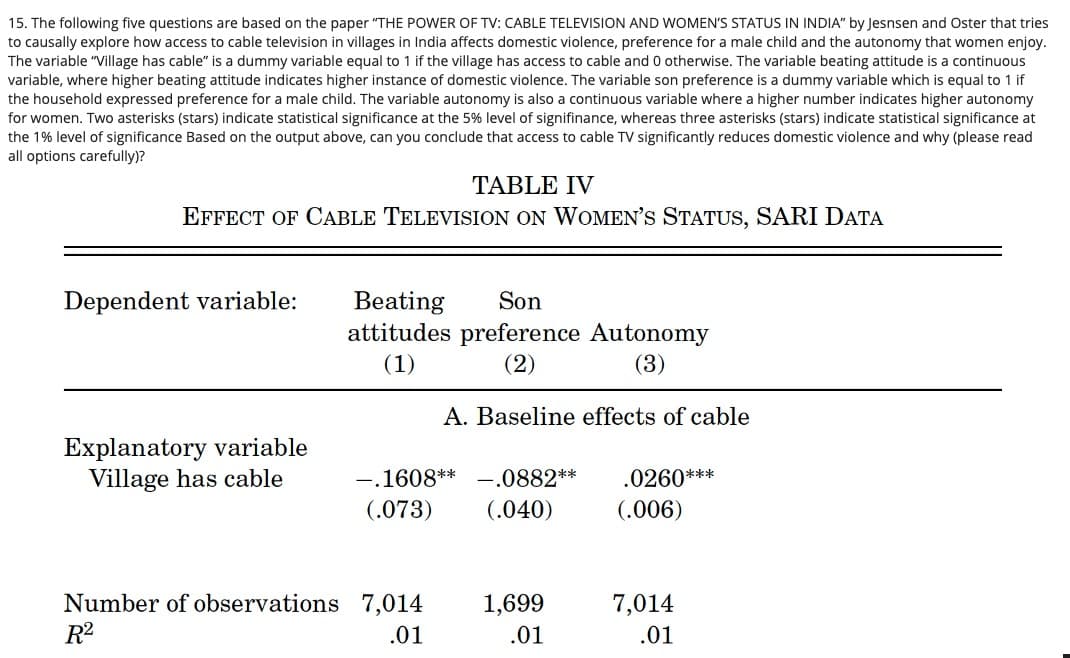8. Do villages with access to cable have a significantly higher preference for a male child and why (please read all options carefully)?? A. a. Yes, because the coefficient is negative B. b. No, because the coefficient is negative C. c. No, because the coefficient is negative and statistically significantly different from zero at the 5% level of significance
8. Do villages with access to cable have a significantly higher preference for a male child and why (please read all options carefully)?? A. a. Yes, because the coefficient is negative B. b. No, because the coefficient is negative C. c. No, because the coefficient is negative and statistically significantly different from zero at the 5% level of significance
Glencoe Algebra 1, Student Edition, 9780079039897, 0079039898, 2018
18th Edition
ISBN:9780079039897
Author:Carter
Publisher:Carter
Chapter10: Statistics
Section10.6: Summarizing Categorical Data
Problem 27PPS
Related questions
Topic Video
Question

Transcribed Image Text:18. Do villages with access to cable have a significantly higher preference for a male child and why (please read all options carefully)??
OA. a. Yes, because the coefficient is negative
OB. b. No, because the coefficient is negative
C. C. No, because the coefficient is negative and statistically significantly different from zero at the 5% level of significance
D. d. No, because the coefficient is negative and statistically significantly different from zero at the 1% level of significance

Transcribed Image Text:15. The following five questions are based on the paper "THE POWER OF TV: CABLE TELEVISION AND WOMEN'S STATUS IN INDIA" by Jesnsen and Oster that tries
to causally explore how access to cable television in villages in India affects domestic violence, preference for a male child and the autonomy that women enjoy.
The variable "Village has cable" is a dummy variable equal to 1 if the village has access to cable and 0 otherwise. The variable beating attitude is a continuous
variable, where higher beating attitude indicates higher instance of domestic violence. The variable son preference is a dummy variable which is equal to 1 if
the household expressed preference for a male child. The variable autonomy is also a continuous variable where a higher number indicates higher autonomy
for women. Two asterisks (stars) indicate statistical significance at the 5% level of signifinance, whereas three asterisks (stars) indicate statistical significance at
the 1% level of significance Based on the output above, can you conclude that access to cable TV significantly reduces domestic violence and why (please read
all options carefully)?
TABLE IV
EFFECT OF CABLE TELEVISION ON WOMEN'S STATUS, SARI DATA
Dependent variable:
Beating
attitudes preference Autonomy
Son
(1)
(2)
(3)
A. Baseline effects of cable
Explanatory variable
Village has cable
.0260***
(.006)
-.1608** -.0882**
(.073)
(.040)
Number of observations 7,014
R2
1,699
7,014
.01
.01
.01
Expert Solution
This question has been solved!
Explore an expertly crafted, step-by-step solution for a thorough understanding of key concepts.
Step by step
Solved in 2 steps

Knowledge Booster
Learn more about
Need a deep-dive on the concept behind this application? Look no further. Learn more about this topic, statistics and related others by exploring similar questions and additional content below.Recommended textbooks for you

Glencoe Algebra 1, Student Edition, 9780079039897…
Algebra
ISBN:
9780079039897
Author:
Carter
Publisher:
McGraw Hill

Glencoe Algebra 1, Student Edition, 9780079039897…
Algebra
ISBN:
9780079039897
Author:
Carter
Publisher:
McGraw Hill